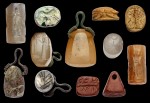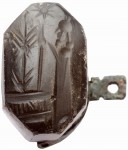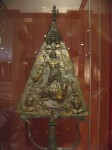 Archaeologists from the University of Münster excavating the ancient sanctuary of Jupiter Dolichenus near the town of Dülük in southern Turkey have unearthed more than 600 stamp and cylinder seals dating from between the 7th and the 4th centuries B.C. Seals were used as votive offerings to the gods and as such have been found at many ancient sanctuaries, but the sheer numbers found here make the discovery unique.
Archaeologists from the University of Münster excavating the ancient sanctuary of Jupiter Dolichenus near the town of Dülük in southern Turkey have unearthed more than 600 stamp and cylinder seals dating from between the 7th and the 4th centuries B.C. Seals were used as votive offerings to the gods and as such have been found at many ancient sanctuaries, but the sheer numbers found here make the discovery unique.
“The amazingly large number proves how important seals and amulets were for the worshipping of the god to whom they were consecrated as votive offerings”, according to Classical scholar [and excavation leader Dr. Engelbert] Winter. Many pieces show scenes of adoration. “Thus, they provide a surprisingly vivid and detailed insight into the faith of the time.” The stamp seals and cylinder seals as well as scarabs, made of glass, stone and quartz ceramics, were mostly crafted in a high-quality manner.
 The seals are carved with a wide variety of images. They range from simple geometric shapes to scenes of heroes battling animals or mythological creatures. One seal depicts men worshiping star-like symbols of divinity.
The seals are carved with a wide variety of images. They range from simple geometric shapes to scenes of heroes battling animals or mythological creatures. One seal depicts men worshiping star-like symbols of divinity.
“Even those images that do not depict a deity express strong personal piety: with their seals, people consecrated an object to their god which was closely associated with their own identity”, said [Dr. Michael] Blömer. People wore the amulets found with the seals in everyday life. “Strung on chains, they were supposed to fend off bad luck”, explained the archaeologist.
The Roman name for Dülük was Doliche, hence the name “Dolichenus” for the Jupiter whose cult was centered around the temple on the hill known today as Dülük-Baba Tepesi. The cult of Jupiter Dolichenus was a mystery religion that was popular all over the Roman empire from the early second century A.D. until its precipitous fall in the mid-third century.  Shrines to Jupiter Dolichenus, who is always depicted holding a thunderbolt in one hand and a double-headed axe in the other while riding a sacred bull, have been found in Rome, Hungary, Romania, Germany, Austria and even in the remote British fort of Vindolanda just south of Hadrian’s Wall. Like Mithraism, another bull-centered Eastern mystery religion, the worship of Jupiter Dolichenus was popular in the Roman army, but it wasn’t restricted to military. Judging from handy lists of adherents that have been found inscribed in some of the 17 known temples, more than 60% of the devotees were civilians.
Shrines to Jupiter Dolichenus, who is always depicted holding a thunderbolt in one hand and a double-headed axe in the other while riding a sacred bull, have been found in Rome, Hungary, Romania, Germany, Austria and even in the remote British fort of Vindolanda just south of Hadrian’s Wall. Like Mithraism, another bull-centered Eastern mystery religion, the worship of Jupiter Dolichenus was popular in the Roman army, but it wasn’t restricted to military. Judging from handy lists of adherents that have been found inscribed in some of the 17 known temples, more than 60% of the devotees were civilians.
Interest in the religion waned rapidly with the end of the Severan dynasty. Emperors like Caracalla and Septimius Severus had supported the religion, so when the last Severan, Alexander Severus, was assassinated in 235 A.D., his successor Maximus Thrax did not look favorably upon it or its adherents. The temple at Doliche was destroyed twenty years later by Sassanid emperor Shapur I. Since the cult was strongly identified with the deity’s original temple, Jupiter’s failure to save his own home from destruction made him look impotent and lost him whatever adherents he had left.
 The seals that have been found long predate the Roman era of Jupiter Dolichenus, however. Like all the Eastern religions that carved a niche out for themselves in Rome, this Jupiter was a syncretized version of a much older deity. He started off as the Hittite sky and storm god Tesub-Hadad and was only blended with the Greco-Roman sky and storm god after the Romans conquered the area in 64 B.C. Most of what we know of this cult is post-Roman, so such a large number of seals from when he was Tesub-Hadad rather than Jupiter are invaluable sources for researchers. So far, archaeologists have identified seals from the Neo-Babylonian, local Syrian, Levantine and Achaemenid periods.
The seals that have been found long predate the Roman era of Jupiter Dolichenus, however. Like all the Eastern religions that carved a niche out for themselves in Rome, this Jupiter was a syncretized version of a much older deity. He started off as the Hittite sky and storm god Tesub-Hadad and was only blended with the Greco-Roman sky and storm god after the Romans conquered the area in 64 B.C. Most of what we know of this cult is post-Roman, so such a large number of seals from when he was Tesub-Hadad rather than Jupiter are invaluable sources for researchers. So far, archaeologists have identified seals from the Neo-Babylonian, local Syrian, Levantine and Achaemenid periods.
“The large find provides new impetus for research to answer unsolved questions of cult practices, cult continuity and cult extension – above all, these are important for the understanding of the early history of the sanctuary in the 1st millennium B.C., which had been unknown until recently”, according to Prof. Winter.
The seals of Dilmun in Bahrain and East Saudi Arabia are very similer,I wounder if they are related see.. https://openaccess.leidenuniv.nl/bitstream/handle/1887/18386/ba-2011-sophietews.pdf?sequence=1
I am such a geek but I LOVE seal stones! Minoan are probably my favorite but the middle eastern ones are fantastic as well. The Morgan Library has a fantastic collection of them for those of you who are lucky enough to be near Manhattan.
Ancient seals seem so fascinating and i want to learn more about them.
meadnova.wordpress.com
If you’re ever near Chicago, the University of Chicago’s Oriental Institute has a wonderful collection as well.